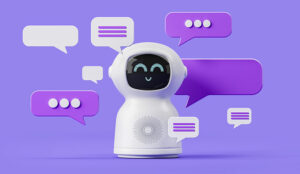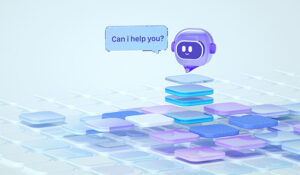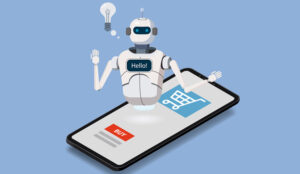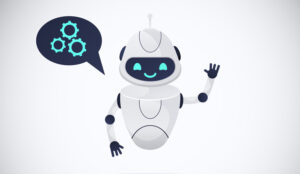Can a chatbot really deliver the same service experience as a human agent?
In this article, we explore chatbots in the contact centre, explaining what they are, how they work, the types available, and the roles they play across industries.
Why Are Chatbots So Popular?
Chatbots have rapidly gained popularity due to their ability to provide instant, 24/7 assistance, making them an invaluable tool for businesses and individuals alike.
Their capacity to engage in natural and human-like conversations, addressing queries and concerns in real time, enhances customer experiences and streamlines interactions. And technology continues to advance, leading to more sophisticated and context-aware chatbots.
The data gathered from our 2023 survey “What Contact Centres Are Doing Right Now?” shows a notable increase in chatbot usage in contact centres, at 38% of readers.
Furthermore, there’s been a significant surge in demand, as evidenced by 38.4% of contact centres expressing interest in incorporating chatbots into their business. This marks a noteworthy increase compared to the 35.6% figure recorded in 2022.
These findings underscore the growing and dependable role of chatbots as a solution. Leaders in contact centre management are increasingly realizing the benefits of chatbot integration and acknowledging the resolution of earlier technological issues over time.
As a result, they now recognize the proficiency of chatbots in handling simple enquiries, thereby enabling human agents to focus on more complex customer issues.
For more insights from our 2023 survey, read our article: The Top Contact Centre Technologies of 2023
What Is a Chatbot?
A chatbot is essentially a computer program which allows communication between customers or website visitors in cases when a human agent is unavailable.it may even replace the initial role of the agent entirely.
Chatbots can engage in voice interactions, but more commonly they employ text-based conversations (or even a blend of both methods).
Whilst initially chatbots were mainly deployed by large multinational companies, designed to offer 24/7 support, they are now so common for businesses that many solutions include a host of different integrations for custom chatbots on your website or other digital channels.
How Do Chatbots Work?
Chatbots are traditionally employed to help customers with simple tasks. They can answer questions, give information, or assist customers with tasks like delivery tracking.
- They make sure they understand what your customer is asking. They analyse words using special algorithms. Then, like us, they can learn and become better at understanding intent over time by using technology such as machine learning.
- They gather important information. This could be details about your customer’s account, an order, or information about a product.
- They use all this information to decide what to say back to your customer. Sometimes they use the specific facts they collected to answer well. In other cases, they use pattern matching and keyword spotting to better calculate their response.
- They give your customer an answer. This might be the information they wanted, or the bot might ask more questions if they’re not sure. Some chatbots will be designed to pass customers on to an advisor (in this case a real person) if the request isn’t straightforward.
We recently released a video on this subject, which can be seen below:
Chatbot Algorithms
What types of algorithms do they use? Whilst there are many different algorithms that can be used for chatbots, we’ve broken down the general process into three steps:
- If your chatbot is voice enabled, then it needs to understand natural language speech and change spoken words into written text. This is called speech recognition.
- After that, it takes that text and uses another set of methods called natural language processing, using a different set of algorithms entirely. These methods help the chatbot understand why the customer is talking and gather important information from the conversation; this is essentially the customer’s intent. This info could be names, addresses, and more things that help the chatbot guide the conversation. For specialized industries, you may need to provide additional context at this stage of programming.
- Next, you’ll need dialogue management, where you create the chatbot’s conversation and lead the customer to their overall goal from the interaction. Some businesses will employ a Conversational Designer for this part of the process, mapping out set paths which they expect customers to take in the conversation. Machine learning can be used at this stage as well, but businesses will need to provide training data.
| Speech Recognition | Natural Language Processing | Dialogue Management & Machine Learning |
|---|---|---|
| Understand natural language speech and convert into text | Identify intent and extract key information | Create the conversation and drive questions and responses. |
We recently released a video about chatbot algorithms that you can watch below:
What Are Chatbots Used For?
Chatbots are employed in many different ways. Customer support is the most common, aiding with enquiries and e-commerce purchases.
Healthcare uses chatbots for basic medical advice and appointment scheduling. Within businesses, chatbots streamline tasks like data retrieval. They also serve as virtual tutors in education.
Types of Chatbot
Chatbots come in a diverse array of types, each designed to fulfil a specific roles and cater to various user needs.
- Rule-based chatbots operate on predefined sets of rules and keywords, suitable for simple tasks like answering frequently asked questions.
- AI-powered chatbots leverage machine learning and natural language processing to engage in more dynamic conversations by comprehending context and learning from interactions over time. Virtual assistants like Siri and Google Assistant fall under this category.
- Task-specific chatbots excel at performing single functions, such as scheduling appointments or making reservations.
- Social chatbots simulate human conversation and are prevalent in customer service, enhancing user experiences.
- There are also voice-activated smart speakers and messaging apps that integrate chatbots to facilitate hands-free interactions and provide quick information.
Measuring Chatbot Performance
We recently asked our panel of chatbot experts about how they would measure the performance of a chatbot.
Knowing how well your chatbot is performing and being able to judge the quality of its customer interactions is vitally important.
- Measure how well you achieved your main goal and compare this to how other channels perform.
- Consider examining the number of cases handled and time spent with the chatbot, along with reduced handling time for cases escalated from the chatbot to a person instead of starting with a person-led channel.
- Consider the net promoter score, reuse rates, and first contact resolution, as these factors can forecast long-term adoption.
For more information on chatbots and how they are used in the contact centre, read these articles next:
- The Difference Between a Bot and a Chatbot
- Chatbots: How Your Business SHOULD Be Using Them – With Examples
- How to Measure Chatbot Performance
Author: Xander Freeman
Reviewed by: Jonty Pearce
Published On: 8th Dec 2023 - Last modified: 1st Sep 2025
Read more about - Technology, Artificial Intelligence (AI), Chatbots





















